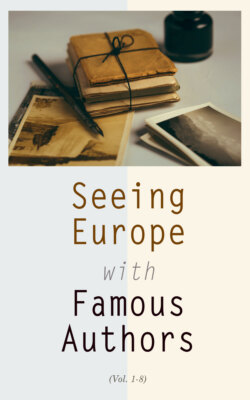Читать книгу Seeing Europe with Famous Authors (Vol. 1-8) - Гарриет Бичер-Стоу - Страница 63
THE HOME OF THE PILGRIM FATHERS1 By James M. Hoppin.
ОглавлениеTwelve miles to the south of Doncaster, on the great Northern line of railway, and just at the junction of Yorkshire, Nottinghamshire, and Lincolnshire, in the county of Nottingham, but bordering upon the fenny districts of Lincolnshire, whose monotonous scenery reminds one of Holland, lies the village of Scrooby. Surely it is of more interest to us than all the Pictish forts and Roman walls that the "Laird of Monkbarns" ever dreamed of. I was dropt out of the railway-carriage, which hardly stopt upon a wide plain at a miniature station-house, with some suspicions of a church and small village across the flat rushy fields in the distance. This was indeed the humble village (tho now beginning to be better known) which I had been searching for; and which nobody of whom I inquired in Doncaster, or on the line of the railway, seemed to know anything about, or even that such a place existed. I made its discovery by the help of a good map. The station-master said he came to Scrooby in 1851, and then it numbered three hundred inhabitants; and since that time there had been but twelve deaths.
My search for the manor-house where Brewster and Bradford established the first church of the Pilgrims, was, for a time, entirely fruitless. I inquired of a genuine "Hodge" working in the fields; but his round red face showed no glimmer of light on the matter so far removed from beans and barley. I next encountered a good Wesleyan minister, trudging his morning circuit of pastoral visitation, but could gain nothing from him, tho a chatty, communicative man. At the venerable stone church of Scrooby, very rude and plain in architecture, but by no means devoid of picturesqueness, I was equally unsuccessful. The verger of the church, who is generally the learned man of the village, was absent; and his daughter knew nothing outside the church and churchyard.
I strolled along the grassy country road that ran through the place till I met a white-haired old countryman, who proved to be the most intelligent soul in the neighborhood. He put his cane to his chin, shut and opened his eyes, and at last told me in broad Yorkshire, that he thought the place I was looking for must be what they called "the bishop's house," where Squire Dickinson lived. Set at last upon the right track, I walked across two swampy meadows that bordered the Idle River—pertinently named—till I came to a solitary farmhouse with a red-tiled roof. Some five or six slender poplar-trees stood at the back of it, and a ditch of water at one end, where there had been evidently an ancient moat—"a moated grange."
It was a desolate spot, and was rendered more so just then by the coming up of a thunder-storm, whose "avant courier," the wind, made the slender poplars and osiers bend and twist. Squire John Dickinson, the present inhabitant of the house, which is owned by Richard Monckton Milnes, the poet, gave me a hearty farmer's welcome. I think he said there had been one other American there before; at any rate he had an inkling that he was squatted on soil of some peculiar interest to Americans. He introduced me to his wife and daughters, healthy and rosy-cheeked English women, and made me sit down to a hospitable luncheon. He entertained me with a discourse upon the great amount of hard work to be done in farming among these bogs, and wished he had never undertaken it, but had gone to America or Australia. The house, he said, was rickety enough, but he contrived to make it do. It was, he thought, principally made of what was once a part of the stable of the Manor House.
The palace itself has now entirely disappeared; "but," said my host, "dig anywhere around here and you will find the ruins of the old palace." Dickinson said that he himself was reared in Austerfield, a few miles off in Yorkshire; and that a branch of the Bradford family still lived there. After luncheon I was shown Cardinal Wolsey's mulberry-tree, or what remained of it; and in one of the barns, some elaborately carved woodwork and ornamental beams, covered with dirt and cobwebs, were pointed out, which undoubtedly belonged to the archiepiscopal palace.
This was all that remained of the house where Elder Brewster once lived, and gathered his humble friends about him, in a simple form of worship. … This manor was assigned to the Archbishop of York in the "Doomsday Book." Cardinal Wolsey, when he held that office, passed some time at this palace. While he lived there, Henry VIII. slept a night in the house. It came into Archbishop Sandys's hands in 1576. He gave it by lease to his son, Samuel Sandys, under whom Brewster held the manor. Brewster, as is now well known, was the Post-Superintendent of Scrooby, an important position in those days, lying as the village did, and does now, upon the great northern line of travel from London to Yorkshire, Northumberland, and Scotland. …
But to look at this lonely and decayed manor-house, standing in the midst of these flat and desolate marshes, and at this most obscure village of the land, this Nazareth of England, slumbering in rustic ignorance and stupid apathy, and to think of what has come out of this place, of what vast influences and activities have issued from this quiet and almost listless scene, one has strange feelings. The storied "Alba Longa," from which Rome sprang, is an interesting spot, but the newly discovered spiritual birthplace of America may excite deeper emotions.
1 From "Old England: Its Scenery, Art and People." Published Toy Houghton, Mifflin Co.
